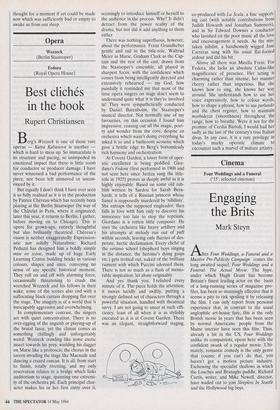Exhibitions
Some Went Mad, Some Ran Away ... (Serpentine, till 4 June)
May Balls
Giles Atli),
The social event of the season so far as youthful avant-garde art is concerned occurred in Hyde Park last week at the Ser- pentine Gallery with the well-attended party to open 'Some Went Mad, Some Ran Away ... ' an exhibition of international radical art curated by Damien Hirst. Per- haps bearing the tender ages of a number
of the participants in mind, the event was sponsored most thoughtfully by the ice- cream makers Haagen-Dazs. A prolifera- tion of young men with earrings and young women shod in paratroopers' boots revealed the importance attached to the event by other ambitious young artists, whose hero Damien Hirst, aka 'the formaldehyde kid', was in the limelight once more. Why he should be so has always seemed something of a mystery which his own exhibits at the Serpentine do little to dispel. I asked a senior trustee of the gallery to explain to me the unique merit of the show. 'It's provocative, at least,' this person replied, implying that all alternative forms of living art are merely dull or deco- rative — hardly an informed or accurate view.
Debates on radical art have become so debased and rhetorical in nature that many have come to imagine that the condition of being provocative — along with those of being modern or innovative — is somehow a virtue in itself. A moment's reflection ought to convince us why this cannot be so. As all change can be as easily for worse as for better so, too, with the effects of sup- posed provocation. Much depends, for a start, on who is being provoked and to what conceivable purpose. For example, I am provoked frequently by art and exhibi- tions which are at once shallow, unintelli- gent and portentous. So are a great many other thinking people. But is this a criti- cism of us or the art?
What I realise increasingly is that I am not the right audience for various much- lauded plays, films, novels and exhibitions of recent vintage. The reason is not so much one of taste and prejudice as of experience. Unlike their presumed targets of breathless adolescents or puzzled matrons I am not looking for something anything — to provide some vague sem- blance of illumination, excitement or signif- icance in my life. When Damien Hirst immerses yet another furry or fishy form in a tank of formaldehyde, as he has done once more at the Serpentine, I am not shocked but profoundly unmoved. Perhaps this is because, before doing military ser- vice, I spent sever al months loading the raw products of slaughterhouses on to the backs of lorries. I realise this experience was unusual and, in a sense, voluntary, however, for better or worse, the memory of doing it cannot be erased. One conse- quence is that, unlike many of my profes- sional colleagues, I do not expect to find the meaning of life by staring at a moth- eaten looking lamb in a tankful of preser- vative.
Apparently this exhibit has netted its author £25,000 already through sale to a private collector. What on earth will the gnomic Mr Hirst choose to pickle for us next? Will he look overseas once more, to shark territory perhaps? What about a kan- garoo with an erection entitled 'Bounder'? I am afraid this more sophisticated variant is covered by my personal copyright already, although I am open to negotiation. The shark-watchers by the Serpentine need not feel disappointed, however, since `Some Went Mad, Some Ran Away ... ' does include one such, made from rope, leather, rubber and PVC by the American- based Ashley Bickerton. But this smacks more of bondage than Bondi; everyone to their taste.
To the surprise of many, I am not as unsympathetic to this show or its artists as may be imagined. The Western world has created a system of publicly-funded art in which inconsequential artists and artefacts attract fame largely because many people, including the disaffected young, are unable to see or place them accurately within any historical or personal context. The fault lies largely in poor education and in the low levels of debate about art in our time. I am happy to have grown up in a different era. A number of the artists in the present show suggest genuine talent and intelligence but are unlikely to realise these fully because of the impoverished formal means they have been encouraged to adopt. However, mere participation in this exhibition will promote further notoriety for the likes of Marcus Harvey, Kiki Smith, Sophie Calle, Angus Fairhurst and Andreas Slominski as well as a good deal of sub-human writing in both the popular and specialist press. Looking at the massed ranks of the gushers and the gormless at the Serpentine party, I thought for a moment if art could be made now which was sufficiently bad or empty to awake us from our sleep.



























































 Previous page
Previous page